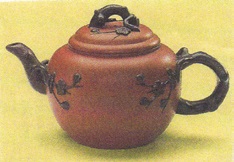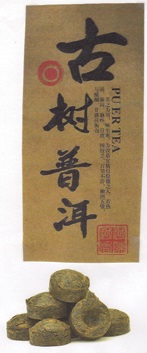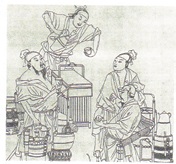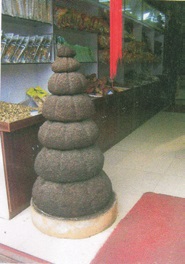
| What is Flavor and Fortune? |
| How do I subscribe? |
| How do I get past issues? |
| How do I advertise? |
| How do I contact the editor? |
Read 12958821 times
Connect me to:
| Home |
| Articles |
| Book reviews |
| Letters to the Editor |
| Newmans News and Notes |
| Recipes |
| Restaurant reviews |
| Article Index (all years, slow) |
| List of Article Years |
| Article Index (2025) |
| Article Index (last 2 years) |
| Things others say |
| Related Links |
| Log In... |
| Authors |
| Categories & Topics |
Tea: Knowledge, Types, and Tastes
| by Jacqueline M. Newman |
Beverages
Spring Volume: 2018 Issue: 25(1) pages: 33 to 37
Tea comes from one plant, Camellia sinensis. Many primitive tea trees are found in China, most in the Yunnan Province; and we did read that one of the largest has a diameter of almost four feet. It is about one hundred twenty feet tall and about seventeen hundred years old. It may not be the oldest, tallest, or the one with the largest trunk diameter. It was found on the slope of Mount Nannuo. There may be an even bigger and older one in Jinggu County, but how big or where we do not know as we lost the article mentioning it.
Yunnan is probably where the world’s first tea trees originated. Most tea sold and consumed in ancient times did grow there and on similar trees. Nowadays, tea grows on bushes as they are pruned to be easy to pick its leaves more easily than they did from these huge trees. Tea leaves are also smaller as they are picked several times a year. The old wild tea trees had larger leaves and were picked less often. Nowadays, tea from these smaller bushes is consumed more often. This may be because more people worldwide drink tea as it is the world’s most popular beverage after water, and the world’s population is larger than ever so more people drink more tea than ever before.

The Tea Research Institute of the Yunnan Academy of Agricultural Sciences is outside the town of Menghai. There, they do lots of research about this plant and its beverage. Visiting there is a great experience as one learns about where tea originated, what tea trees and bushes are available and where, and so much more. We read there that are three hundred and eighty different teas in Yunnan and throughout China, all coming from one species.
Though it sounds like an oxi-moron, the oldest living trees are in the ‘virgin’ forest of Dahei Mountain. The Blang are believed to be the first cultivators of tea, and they still live in the Village of Hesong where they love their special tea made sour. They did use big mature leaves that they steamed first, then dried, then tightly packed in old bamboo tubes. These, they buried in the ground for several months to two years.
Records in Xiangming and Yiwu, two districts of Mengla County, did produce tea in large quantities twelve hundred years ago, perhaps even earlier. Their teas came from one of ten tea-producing mountains in this region. It did dominate the tea trade, and they frequented one of the more than thirty tea depots there. Tea horse caravans were loaded their tea daily during all picking seasons. So were other teas.
Some descendants of former tea merchants still live in this county. The Customs House where lots of their tea was sold no longer sells any. It was in use until near the end of the Qing Dynasty, and still stands today. In it is a stone tablet in its guild hall saying that a hundred and fifty years ago, there were tea merchants who refused to pay high taxes on teas sold there. We never knew the Boston Tea Party was not the first negative reaction against tea taxes.
People say that Prime Minister Zhuge Liang, a strategist living in the Jinou Mountains was one of the first to make tea with large tea leaves. He lived in the State of Shu during the Three Kingdoms period (220 - 280 CE), and is credited with pioneering tea drinking in this region.

On his birthday, the 23rd day of the 7th lunar month, the Jinuo minority people remember and honor him by preparing tea as he did. They age then heat adding water to their tea leaves then heating them over braziers. Earlier, their tea was wrapped in phrynium leaves and put into bamboo sections then roasted over a fire. These days they put tea leaves into bamboo sections and boil them for a few minutes on his birthday. Actually, he did teach them to use tea leaves to cure hangovers by cooking them this way or adding salt and hot pepper to their tea leaves.
Pu-er tea does not usually come from this region and is a multi-fermented tea once only made with black tea leaves that the Chinese call red tea. They are referring to the color of the brew while black is the color of theses dried leaves. The term pu-er today is not often used, because this fermented tea is more often simply called ‘Yunnan Tea’ whether compressed or loose. It is also now made with green or black tea leaves.

When processed, they are sun-dried or oven-heated, and these tea leaves change to very dark green. The Chinese still categorize their teas by the color of the brew. There are some tea leaves pressed when damp, others dried first. Most have many polyphenols and/or catechin components; and many say they improve the elasticity of the blood vessels of those who drink lots of tea. They also say this tea decreases blood pressure. This process is called oxidation and is said to improve the taste of the tea the longer it is oxidized. Tea made this way is also said to provides strong digestive and salivary functions when steamed; and the older it is, also the better these pu-er teas taste.
Pu-er tea is sold loose but earlier was always in toucha disks with their indentation on the under side (See this on page 32). Usually round, they can be square or as cakes, and some are known as Jincha. These are popular in Tibet where this tea is preferred as ‘butter’ tea.
Many think of tea only as a beverage, but in ancient China, it was used as an herb, a soup, as a vegetable, and as a beverage. A special ancient brew was called ‘Lei’ tea, and General Zhang Fei did inspect it in Wuling County giving it to those suffering from migraine headaches. He brewed that tea with fresh tea leaves, rice, ginger, and salt. He touted it that way to help them recover from migraine headaches. Some did add cooked peanuts, sesame seeds, and pepper, and they liked it even more when it did a better job of curing these migraines.
If you visit a Tibetan home and are offered buttered tea or get to order some in a restaurant, do watch them break up the brick tea and mix it with salt, butter, and sometimes with spices. Then they filter out the tea leaves, and beat the liquid before serving it.
Before drinking this tea, we saw one chap flick off drops of this tea three times. We were told he was paying his respects to the Heavenly God, the Earth God, and the Dragon God. He then drank it and we were told it would help him resist the cold and dampness; even build up his immunity.
After Princess Wen Cheng married Tibetan King Songstan Gambo, it did help his digestion, so people said it was a good source of vitamins missing from the diet, so she convinced him and they did drink it several times a day.
Drinking different teas with the Chinese, one learns how the Han and how their minority neighbors drink tea. Each Chinese ethnic minority nationality drinks tea differently; and they use different teas in different regions. Only Tibetans drink buttered tea. The Blang drink sour tea, most others drink their own special teas; and the Bai enjoy theirs as three course tea.
According to historical documents, tea caravans used some fifty thousand horses each year to carry tea to different regions of China. While no caravan had thousands of horses, there were thousands of caravans transporting tea every year. Some had only a couple of horses, many had a hundred, even three to five hundred with packs of tea saddled to their sides. When it rained that tea could get wet, if it was exceptionally hot, it might dry-fry, etc.
All tea did arrive at its destinations in various ways. Many caravans had arduous journeys, their water or food might run out or get stolen, or they experienced other difficulties. Most caravans had problems one time or another, particularly on nights they did not bed down in a caravanserai.

Some routes had government monopolies that did control the tea trade. Some experienced hazardous journeys, some were lucky and had no problems. One caravan, a Ming Imperial Court did prohibit their moving tea shrubs and exchanging tea seeds as they did not want individuals or groups to grow or sell tea. They wanted it all for themselves. Today, tea is traded freely, in earlier times it was not.
In Mojiang on an ancient caravanserai street in their town, they sold Yenzhen Tea, a local specialty, These leaves were rolled tightly, brewed in hot water, and enjoyed sweet. They also sold shellac, but what that relationship was or why we know not. Here, Hani women wore special head gear, had leggings and belts embroidered with floral designs, and traded them and tea often. Some traded it for fast food or fast horses.
In Kunming, a cultural center in the Yunnan Province, there were two main highways selling tea for these fast horses. On Stone Street, there was a well--polished road where everyone did slip and slide when it rained. In a tiny town in Tonghai was a large Mongolian community that had their tea their way. Here, these men were probably offspring of soldiers once garrisoned here, so they did enjoy strong tea made with big tea leaves, and they had cubes of sugar between their teeth. This reminded me of my grandma who always had her tea with one or more sugar cubes in her teeth. She was not Chinese nor Mongolian, she was Polish.
The Dai, Hani, and the Jingpo had Bamboo Tea steamed, sun-dried, sealed, and cooked in bamboo. Some had Rose Tea fried with nuts, soybeans, sesame seeds, popcorn, and rose petals. It was fried until dark brown. Tea in China is consumed by all fifty-five minority groups, and in more than one hundred sixty other countries, and on five continents.
Tea as a beverage is loved by many folk world-wide. It is loved in high and dry regions, it helps increase saliva and it quenches thirst. It stimulates and relieves tiredness, and many Chinese, drink thirty or more cups a day as some Tibetans do. Mongolians drink milk tea with toasted rice in it, some drink it only once a day, others do so a dozen times every day. Some have ceremonial ways to drink tea.
How do you drink or eat your tea? Below are some recipes to use tea. Most are popular among the Chinese. During the Tang Dynasty (618 - 907 CE), some rulers did collect tea taxes, some dumped tea because of a tea tax. We know of no tea tax today; do you?
During the Ming Dynasty (1368 - 1644 CE) people had to pay a tea toll when transporting it. In some times, merchants had to pay or carry ‘toll coupons. If they did not, they did receive severe penalties including beheading if they did not. Tea rules, tea types, tea tolls, and tea penalties did exist all over China. That country is the largest tea-consuming nation in the world. We hope you will enjoy your tea in as many ways and as often as many Chinese do. In the meantime, enjoy some of the Chinese tea recipes that follow.
| Spiced Tea Eggs |
|---|
18 eggs,
1. Put eggs in pot of cold water, slowly bring the water
to the boil, reduce the heat, and simmer for fifteen
minutes, then let them cool for an hour. Now drain
them, and lightly roll them one by one on a hard surface
cracking the shells, not breaking nor peeling them.
|
| Spare Ribs in Tea |
|---|
3 Tablespoons jasmine tea leaves in a big loose tea bag or loosely knotted in cheese cloth.
1. Mix tea leaves with one cup boiling water, and let
steep for ten minutes.
|
| Pork Belly, Rice Noodles, and Jasmine Tea |
|---|
2 - 3 ounces dry wide mung bean noodles
1. Soak mung bean noodles until soft, then simmer
them for ten minutes, drain, and cut them into two-inch
pieces, and mix them with half the vegetable oil, and
set them aside.
|
| Tea-Smoked Beef |
|---|
4 pounds short ribs, bones removed, the meat of each one cut in half
1. Mix rib meat and the corn or potato starch and set
aside for ten minutes.
|
| Camphor Tea Duck |
|---|
1 whole duck, feet removed, head left on
1. A day or two before beginning to cook, dry the duck
inside and out, and press down on its breast bone to
crack its ribs; and then rub outside and inside with a
mixture of the Himalayan pink salt, peppercorns, and
rice wine, and refrigerate over night or as much as for
two days, lightly covered, with plastic wrap. Turn the
duck over several times during this time.
|
| Tea-Flavored Quail Eggs |
|---|
30 quail eggs
1. Simmer the quail eggs for five minutes, then let them
cool, and gently roll and crack the shells on a hard
surface, do not peel them yet.
|
| Shrimp and Dragon Well Tea |
|---|
1 pound fresh shrimp, shells left on, veins discarded
1. Mix shrimp with salt and egg white, then add the
potato starch and chill for two or three hours in the
refrigerator.
|
| Apricot Kernels, Tea, and Egg Whites |
|---|
1 cup apricot kernels, soaked until soft, then drained and blended
1. Put apricot kernels into a blender with four cups
of cold water, and blend until smooth, then pour this
apricot-kernel-liquid through cheese cloth set over a
bowl and drain saving the liquid and discarding the
ground kernels.
|
| Green Tea and Water Chestnut Dessert |
|---|
2 Tablespoons cornstarch, divided in three parts
1. Put tea leaves in one cup very hot water and steep
for five minutes, then drain the tea leaves on paper
towels and mix with one-third (or two teaspoons) of
the cornstarch.
|

Copyright © 1994-2025 by ISACC, all rights reserved
Address
3 Jefferson Ferry Drive
S. Setauket NY 11720